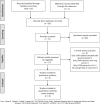The prognostic values of neutrophil to lymphocyte ratio for outcomes in chronic obstructive pulmonary disease
- PMID: 31305434
- PMCID: PMC6641779
- DOI: 10.1097/MD.0000000000016371
The prognostic values of neutrophil to lymphocyte ratio for outcomes in chronic obstructive pulmonary disease
Erratum in
-
The prognostic values of neutrophil to lymphocyte ratio for outcomes in chronic obstructive pulmonary disease: Erratum.Medicine (Baltimore). 2019 Aug;98(32):e16859. doi: 10.1097/MD.0000000000016859. Medicine (Baltimore). 2019. PMID: 31393418 Free PMC article. No abstract available.
Abstract
Objective: Neutrophil to lymphocyte ratio (NLR) is considered as an inflammatory biomarker for clinical outcomes in patients with chronic obstructive pulmonary disease (COPD). We aimed to conduct a meta-analysis to evaluate the prognostic values of NLR for the exacerbation and mortality in patients with COPD.
Methods: We searched the database of Cochrane Central Register of Controlled Trials, EMBASE, and PubMed, before September 2017. The eligible studies were retrieved by 2 authors independently following the criteria. The pooled odds ratios (ORs) of included studies were used to evaluate the prognostic values of NLR. Subgroup analyses were conducted to make the results more accurate.
Results: Nine studies with 5140 patients were enrolled in this analysis. The high NLR was associated with higher risk of exacerbation (OR: 3.81, 95% confidence interval [CI]: 1.20-12.13, P = .02) and mortality (OR: 2.60, 95% CI: 1.48-4.57, P < .01). By subgroup analysis, high NLR could predict the mortality in patients >70 years (OR: 2.16, 95% CI: 1.17-3.98, P = .01) but not in patients <70 years (OR: 4.08, 95% CI: 0.91-18.24, P = .07), and had a higher predictive ability in Asian group (OR: 3.64, 95% CI: 1.87-7.08, P < .01) than Eurasia group (OR: 1.82, 95% CI: 1.43-2.32, P < .01). In addition, high NLR could predict the short-term mortality (OR: 2.70, 95% CI: 1.10-6.63, P = .03) and the long-term mortality (OR: 2.61, 95% CI: 1.20-5.65, P = .02).
Conclusions: The NLR may be an independent predictor for incidence of exacerbation in patients with COPD. In addition, high NLR may be associated with higher mortality in patients with COPD, especially for Asian and the patients with higher mean NLR.
Conflict of interest statement
The authors have no conflicts of interest to disclose.
Figures




Similar articles
-
Predictive value of neutrophil-lymphocyte ratio for all-cause mortality in patients with chronic obstructive pulmonary disease: a systematic review and meta-analysis.BMC Pulm Med. 2025 Apr 29;25(1):206. doi: 10.1186/s12890-025-03677-y. BMC Pulm Med. 2025. PMID: 40301774 Free PMC article.
-
Prognostic Value of Neutrophil to Lymphocyte Ratio for Predicting 90-Day Poor Outcomes in Hospitalized Patients with Acute Exacerbation of Chronic Obstructive Pulmonary Disease.Int J Chron Obstruct Pulmon Dis. 2023 Jun 14;18:1219-1230. doi: 10.2147/COPD.S399671. eCollection 2023. Int J Chron Obstruct Pulmon Dis. 2023. PMID: 37337582 Free PMC article.
-
The predictive value of neutrophil-to-lymphocyte ratio for chronic obstructive pulmonary disease: a systematic review and meta-analysis.Expert Rev Respir Med. 2020 Sep;14(9):929-936. doi: 10.1080/17476348.2020.1776613. Expert Rev Respir Med. 2020. PMID: 32938249
-
Usefulness of neutrophil to lymphocyte ratio in patients with chronic obstructive pulmonary disease: a prospective observational study.Korean J Intern Med. 2016 Sep;31(5):891-8. doi: 10.3904/kjim.2015.084. Epub 2016 Mar 25. Korean J Intern Med. 2016. PMID: 27017385 Free PMC article.
-
Predictive value of neutrophil-to-lymphocyte ratio for adverse outcomes in hospitalized patients with acute exacerbation of chronic obstructive pulmonary disease: A retrospective study.Medicine (Baltimore). 2024 Sep 20;103(38):e39797. doi: 10.1097/MD.0000000000039797. Medicine (Baltimore). 2024. PMID: 39312330 Free PMC article.
Cited by
-
The Relationship Between Prognostic Nutritional Indexes and the Clinical Outcomes of Patients with Acute Exacerbation of Chronic Obstructive Pulmonary Disease.Int J Chron Obstruct Pulmon Dis. 2023 Jun 12;18:1155-1167. doi: 10.2147/COPD.S402717. eCollection 2023. Int J Chron Obstruct Pulmon Dis. 2023. PMID: 37332836 Free PMC article.
-
Neutrophil-to-lymphocyte ratio and mortality in the United States general population.Sci Rep. 2021 Jan 11;11(1):464. doi: 10.1038/s41598-020-79431-7. Sci Rep. 2021. PMID: 33431958 Free PMC article.
-
Correlation between the neutrophil-to-lymphocyte ratio and the 90-day all-cause mortality in patients with acute respiratory failure: a retrospective analysis based on the MIMIC-IV Database.BMC Cardiovasc Disord. 2025 Feb 18;25(1):108. doi: 10.1186/s12872-025-04553-7. BMC Cardiovasc Disord. 2025. PMID: 39966744 Free PMC article.
-
Optimizing inhaled corticosteroid use in patients with chronic obstructive pulmonary disease: assessing blood eosinophils, neutrophil-to-lymphocyte ratio, and mortality outcomes in US adults.Front Immunol. 2023 Nov 15;14:1230766. doi: 10.3389/fimmu.2023.1230766. eCollection 2023. Front Immunol. 2023. PMID: 38035096 Free PMC article.
-
Prediction of individual mortality risk among patients with chronic obstructive pulmonary disease: a convenient, online, individualized, predictive mortality risk tool based on a retrospective cohort study.PeerJ. 2022 Dec 6;10:e14457. doi: 10.7717/peerj.14457. eCollection 2022. PeerJ. 2022. PMID: 36523463 Free PMC article.
References
-
- Vogelmeier CF, Criner GJ, Martinez FJ, et al. Global strategy for the diagnosis, management, and prevention of chronic obstructive lung disease 2017 Report. GOLD executive summary. Am J Respir Crit Care Med 2017;195:557–82. - PubMed
-
- Hoyert DL, Xu J. Deaths: preliminary data for 2011. Natl Vital Stat Rep 2012;61:1–51. - PubMed
-
- Thomsen M, Ingebrigtsen TS, Marott JL, et al. Inflammatory biomarkers and exacerbations in chronic obstructive pulmonary disease. JAMA 2013;309:2353–61. - PubMed
-
- Jones PW, Agusti AG. Outcomes and markers in the assessment of chronic obstructive pulmonary disease. Eur Respir J 2006;27:822–32. - PubMed
Publication types
MeSH terms
Substances
LinkOut - more resources
Full Text Sources
Medical

